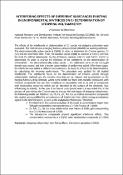Options
Interfering effects of different substances existing in environmental matrices on Cr determination by stripping voltametry
Date issued
2014
Author(s)
Badescu, Valeriu
Stefanescu, Mihai
Abstract
The effects of the interferents on determination of Cr species via stripping voltametry were evaluated. The method uses a hanging Mercury drop electrode (HMDE) as working electrode.
The electrochemically active specie is Cr(VI). In order to determine the Chrome species, Cr (VI) will be determined first. Then, the inactive specie Cr(III) is oxidized at Cr(VI) and thus the total Cr will be determined. By the difference between total Cr and Cr(VI), Cr(III) is determined. In order to analyze the influence of the interferents on the determination of Chrome(VI) – the electrochemically active specie –, the calibration curve on the 0,2-1μg/l domain was created, and then a known concentration of analyte was added. After these stages, the interferent was added in different concentrations, to study its effect on the determinations, by calculating the recovery performance. This procedure was applied for all studied interferents. The interferents found in the determination of Chrome species through voltammetric methods are: the metallic ions that can be reduced and accumulated on the hanging Mercury drop electrode, where some metals can form inter-metallic compounds with Chrome; compounds that can form complexes or precipitates with it; as well as compounds with tensioactive properties which can be adsorbed on the surface of the electrode, thus influencing its activity. In the case of surface or underground waters, it was noted that, in the process of determining the Chrome species through the techniques of stripping voltammetry, the following metals can interfere: Cu, Pb, Fe, Zn, Mn, Co, as well as tensioactive compounds. We studied and quantified the concentrations of interferents from which strong perturbations appear in the determinations, as well as the analyte/interferent ratio. Therefore:
Fe interferes in the correct evaluation of the result at concentrations higher than 500μg/l concentration corresponding to a Cr(VI):Fe ratio of 1:1000;
Zn, Mn, Cu, Ni, Co show interferences over values of 1000 μg/l corresponding to a Cr(VI):Metal ratio of 1:2000;
The tensioactive compounds present significant interferent effects. This concentration corresponds to a Cr(VI) ratio: tensioactive compounds of 1:6000.
The electrochemically active specie is Cr(VI). In order to determine the Chrome species, Cr (VI) will be determined first. Then, the inactive specie Cr(III) is oxidized at Cr(VI) and thus the total Cr will be determined. By the difference between total Cr and Cr(VI), Cr(III) is determined. In order to analyze the influence of the interferents on the determination of Chrome(VI) – the electrochemically active specie –, the calibration curve on the 0,2-1μg/l domain was created, and then a known concentration of analyte was added. After these stages, the interferent was added in different concentrations, to study its effect on the determinations, by calculating the recovery performance. This procedure was applied for all studied interferents. The interferents found in the determination of Chrome species through voltammetric methods are: the metallic ions that can be reduced and accumulated on the hanging Mercury drop electrode, where some metals can form inter-metallic compounds with Chrome; compounds that can form complexes or precipitates with it; as well as compounds with tensioactive properties which can be adsorbed on the surface of the electrode, thus influencing its activity. In the case of surface or underground waters, it was noted that, in the process of determining the Chrome species through the techniques of stripping voltammetry, the following metals can interfere: Cu, Pb, Fe, Zn, Mn, Co, as well as tensioactive compounds. We studied and quantified the concentrations of interferents from which strong perturbations appear in the determinations, as well as the analyte/interferent ratio. Therefore:
Fe interferes in the correct evaluation of the result at concentrations higher than 500μg/l concentration corresponding to a Cr(VI):Fe ratio of 1:1000;
Zn, Mn, Cu, Ni, Co show interferences over values of 1000 μg/l corresponding to a Cr(VI):Metal ratio of 1:2000;
The tensioactive compounds present significant interferent effects. This concentration corresponds to a Cr(VI) ratio: tensioactive compounds of 1:6000.
Files
Loading...
Name
INTERFERING EFFECTS OF DIFFERENT SUBSTANCES EXISTING IN ENVIRONMENTAL MATRICES ON Cr DETERMINATION BY STRIPPING VOLTAMMETRY BENA 2014 V. Badescu.pdf
Size
121.56 KB
Format
Adobe PDF
Checksum
(MD5):8177b3ca7c7a6dc80073784325954eec